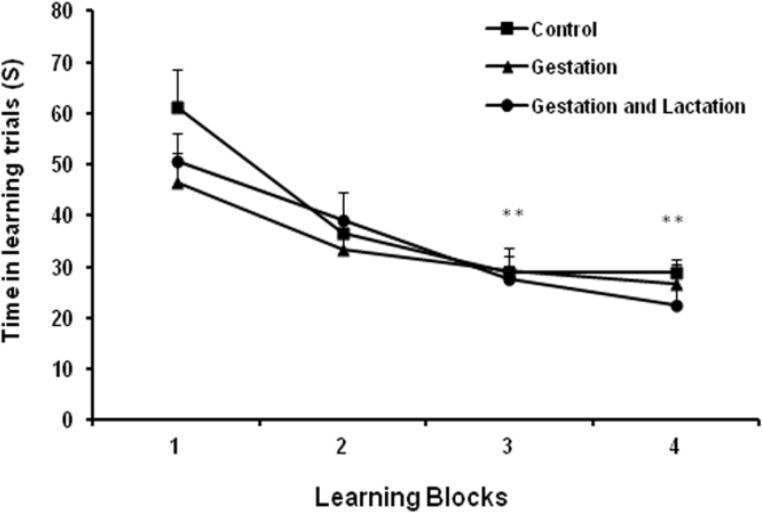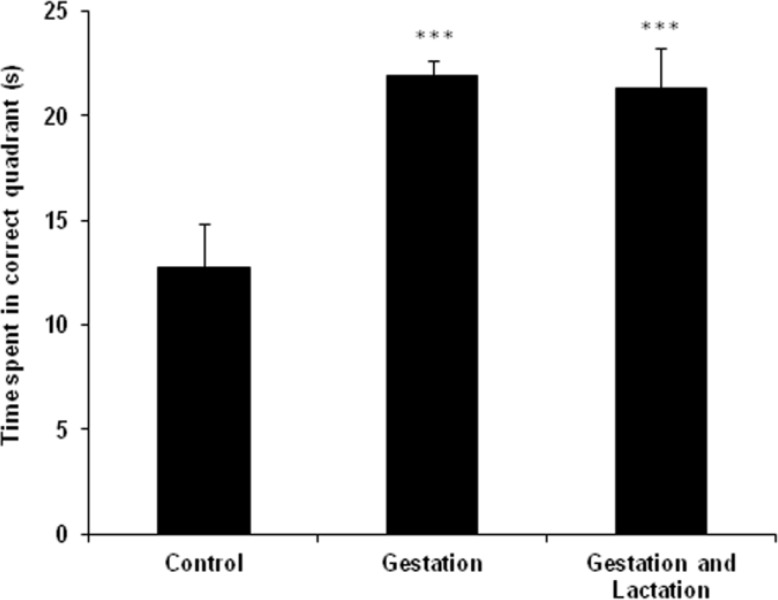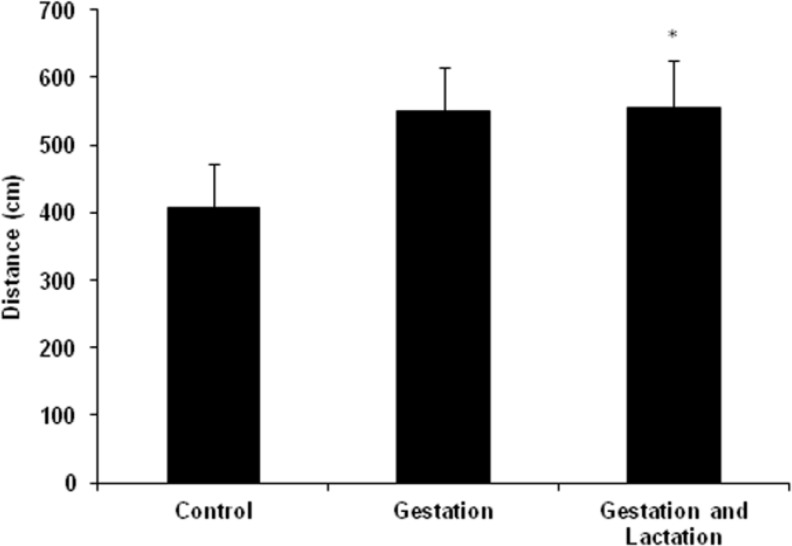Abstract
Objective: Walnut (Juglans Regia) is a domestic fruit of Iran. Walnut kernel (WK) has many beneficial constituents such as unsaturated fatty acids, antioxidants, and vitamin E. Scientific studies have shown that fatty acids and vitamin E can modulate learning and memory processes. The aim of the present work was to study effects of walnut consumption by mothers during pregnancy and lactation on learning and memory in adult rat offsprings.
Materials and Methods: The animals were divided into three groups: control (fed with ordinary food, 20 g daily), gestation (fed with WK, 6% of food intake during pregnancy), and gestation and lactation (fed with WK, 6% of food intake during gestation and lactation). Morris water maze test was performed for their adult offsprings.
Results: The results showed that there was a significant difference in learning and memory of rat offsprings between experimental and control groups.
Conclusion: These data may indicate that feeding mothers with WK results in improvement in learning and memory of their offsprings.
Key Words: Learning, Memory, Morris Water Maze, Rat, Walnut
Introduction
Walnut species are the main source of nuts in mild climate zones around the world. In Iran, Juglans regia L. (Juglandaceae) is not just an agricultural product; its fruit, leaves, stems and flowers are all used for different medicinal purposes. Walnut kernels (WK) have high concentrations of phenolic compounds, which have beneficial effects on human health because of their anticonvulsant, neuroprotective, antioxidant, and anti-atherogenic properties (Li et al., 2007 ▶; Zhang et al., 2009 ▶; Asadi-Shekaari et al., 2012 ▶; Shabani et al., 2012a). In addition, walnut kernels are a nutrient-rich food, containing plentiful of phospholipids, proteins, polyunsaturated fatty acids (PUFA), and tocopherols (Li et al., 2007 ▶).
Different studies have shown that fatty acids and vitamin E can modulate learning and memory processes (Wu et al., 2004 ▶; Poulose et al., 2012 ▶). Walnut is extensively used in traditional medicine for treatment of various ailments such as tonifying the kidney, warming the lungs, and relaxing the bowels (Wang et al., 2004 ▶) and there are several findings that show its consumption can improve cognitive function in aged rats (Willis et al., 2009 ▶). Since some local reports are consistent with the memory enhancing effects of walnut, the aim of the present work was to study effects of walnut consumption by mothers during pregnancy and lactation on learning and memory in adult rat offspring.
Materials and Methods
Animals
Wistar adult female rats were used in this study. Kerman University of Medical Sciences Ethics Committee approved the procedures for this study (EC/KNRC/89-14). Animals were housed in standard conditions including temperature of 22±2 ºC and 25% humidity. Adult female rats, weighing 200–250 g, were housed for 2 weeks before mating at constant room temperature (22-25 °C) with light cycle of 12 h/12 h (7:00 AM to 19:00 PM) and free access to food and water ad libitum. Pairs of females were then placed with a single male rat in the late afternoon. Vaginal smears or plugs were examined the following morning. The day in which sperm was found, has been designated as the gestation day of 0 (GD 0). Then, pregnant rats were randomly divided into three groups: control (fed with ordinary food, 20 g daily) (Thomas et al., 2002 ▶), gestation (G) (fed with WK, 6% of food intake during pregnancy), and gestation and lactation (G-L) (fed with WK, 6% of food intake during gestation and lactation).
Plant Material
The WK was collected from Rabor area, Kerman province, Iran in September, 2010. A voucher specimen was deposited at the herbarium of Pharmacy faculty of Kerman Medical University (No. 1401-1).
Learning and memory evaluation using Morris water maze test
At 80 d old, spatial memory was evaluated using a modified version of the Morris water maze (MWM), in which rats learned to get away from the water onto a hidden platform (Morris, 1984). The maze consisted of an Iron circular (1.36 m in diameter and 60 cm high) filled with cloudy water with 20±1 oC temperature. Animals were challenged to find a hidden platform (10 cm in diameter and 25 cm high) located 1.5 cm below water level (26.5 cm) and in the same place during the entire trial.
The platform was always placed 30 cm beyond the rim of the pool in the center of one quadrant with respect to the distal visual cues. Swimming patterns were analyzed and the following factors were computed: latency (time spent by the rats to find the hidden platform [seconds]), time in over a quarter of, distance traveled in target quadrant (centimeters) and swimming speed (cm/s). The experiment was performed over 4 consecutive days to test their learning, when rats were located into the water facing the rim from 4 different starting points in the pool, with the platform kept in the same place and with a 1-min interval between each trial. The rats were trained in the maze during 13 trials, 4 sessions on consecutive 4 days except for the last day. The animals had to swim to find the hidden platform in 90 s (maximum time), where they were allowed to stay for 30 s. If they failed to find the platform, rats were placed on it for 10 s to associate spatial cues of the room (pictures, cabinets, and light source). One day after the last learning trial, the animals underwent a probe trial to test their long-term spatial memory. For this purpose, time spent by the rats in the target quadrant was recorded and analyzed (Shabani et al., 2012b ▶).
Statistical Analysis
Data were presented as mean±SEM of the mean and were analyzed using one-way analysis of variance (ANOVA) followed by the Tukey’s post hoc test and p<0.05 was considered statistically significant.
Results
Weight
There was no significant difference between rat offspring’s weight in different groups.
Effect of maternal feeding with WK on learning parameters in adult pups
There was not a significant latency decrease for the WK (G, G-L) on the 4th day compared with control (Figure 1, p>0.05). Time spent to reach the hidden platform decreased in all groups in days 3 and 4 compared with day 1 (Figure 1, p<0.01). There was no significant difference in swimming time among all groups in block 1 and 2 in the acquisition test. Although, the difference was not significant but WK adult pups demonstrated better ability in learning the position of the platform using visual cues (spatial memory). As shown in Figure 2, WK adult pups presented more time (s) in over a quarter of target compared with controls, 12.87±2.10, 21.90±0.74, and 21.26±1.95, respectively, (p<0.001).
Figure 1.
Hidden platform training in the learning phase after maternal and lactation feeding with walnut. Time spent to reach the hidden platform decreased in all groups in blocks (days) 3 and 4 compared with block 1. There was no significant difference in swimming time among all groups in block 1 and 2 in the acquisition test. ** p<0.01, as compared with block 1
Figure 2.
Effects of maternal feeding with WK on time in over a quarter of target of adult pups. WK adult pups presented more time (s) in over a quarter of target compared to controls (***p<0.001).
Figure 3.
Effects of maternal feeding with WK on distance (cm) traveled by adult pups in target quadrant. *p<0.05: compared to control
Probe trial test
There was a significant difference (p<0.001) in time (s) spent by the rats in the target quadrant for WK adult pups (G, G-L) on the probe trial compared with control, 18.67±3.89, 25.64±3.63, and 29.04±3.95, respectively.
Discussion
In this study, spatial learning and memory were evaluated in adult pups of rats with WK diet or control diet throughout gestation and lactation. According to the data, animals in WK diet groups exhibited improved spatial learning and memory performance on the MWM. To our knowledge, this is the first report to demonstrate the beneficial effects of maternal feeding with WK on cognitive in adult pups of rats.
Some studies have shown a positive effect of poly unsaturated fatty acids (PUFA) on rodent behavior (Alessandri 2004; Hooijmans, 2009 ▶). Α-linolenic acid (ALA) and linoleic acid (LA) at a 1:4 ratio improved MWM performance in young rats (Yehuda and Carasso, 1993 ▶). ALA and LA supplementation have also been shown to impact on learning and memory in mouse, resulting in improved performance on Sidman avoidance test and in light-dark discrimination learning (Umezawa et al., 1995 ▶).
Maternal fatty acid (FA) nutrition during pregnancy and lactation determines the transfer of the essential fatty acids (EFAs) (LA and ALA) and non-essential FA through the placenta and milk (Innis, 2007 ▶). Although lipid transfer through the placenta is very limited, changes in dietary FAs have implications in fetal and postnatal central nervous system (CNS) development (Herrera, 2002 ▶). In fact, the EFAs and their longer-chain, more unsaturated derivatives provide the precursors for eicosanoids (arachidonic acid, AA) and are important constituents of cell membranes, especially those in the brain tissue (docosahexanoic acid, DHA). The type and amount of FAs in the diet may alter the brain membrane lipid composition involved in cognitive behavior (Santos de Souza, 2012 ▶).
WK have high amount of PUFA which could be accounted for the effects of supplementation on cognitive performance. WK has also many beneficial constituents such as melatonin, vitamin E, folate, and polyphenols which could also contribute to the effects of WK supplementation. Melatonin has been shown to improve elevated-plus maze and passive avoidance performance in old mice (Raghavendra and Kulkarni, 2001 ▶). In addition, vitamin E and melatonin will improve MWM performance in diabetic rats (Tuzcu and Baydas, 2006 ▶). Furthermore, polyphenols in WK (its main antioxidant constituent) can improve behavioral performances (Willis et al., 2009 ▶). A large body of literatures has been suggested that dietary antioxidants can improve cognitive performance (Polidori et al., 2009 ▶; Krikorian et al., 2010; Kesse-Guyot et al., 2011 ▶). In addition, dietary antioxidants primarily influence the development of cognition and behavior during a critical period of life. Moreover, a recent study has suggested that vitamin A, vitamin E status, and vitamin E transfer rate had beneficial effects on children’s cognitive and behavior development quotients by multiple linear regression analysis (Chen et al., 2009 ▶).
According to our data, maternal feeding with WK has beneficial effects on learning and memory in adult pups of rats. These effects were more obvious when the WK supplemented to maternal diet during G-L period. Considering the large number of compounds within WK and beneficial effects of WK supplementation in the present study, the exact mechanism is not known and needs complementary works to clarify the related mechanism.
Acknowledgment
This study was supported by a research grant from Neuroscience Research Center of Kerman University of Medical Sciences. This manuscript was extracted from a graduate student thesis in physiology.
Conflict of Interest
There is not any conflict of interest in this study.
References
- Alessandri JM, Guesnet P, Vancassel S, Astorg P, Denis I, Langelier B, Aïd S, Poumès-Ballihaut C, Champeil-Potokar G, Lavialle M. Polyunsaturated fatty acids in the central nervous system: evolution of concepts and nutritional implications throughout life. Reprod Nutr Dev. 2004;44:509–538. doi: 10.1051/rnd:2004063. [DOI] [PubMed] [Google Scholar]
- Asadi-Shekaari M, Kalantaripour TP, Arab Nejad F, Namazian E, Eslami A. The anticonvulsant and neuroprotective effects of walnuts on the neurons of rat brain cortex. Avicenna J Med Biotechnol. 2012;4:155–158. [PMC free article] [PubMed] [Google Scholar]
- Chen K, Zhang X, Wei XP, Qu P, Liu YX, Li TY. Antioxidant vitamin status during pregnancy in relation to cognitive development in the first two years of life. Early Hum Develop. 2009;85:421–427. doi: 10.1016/j.earlhumdev.2009.02.001. [DOI] [PubMed] [Google Scholar]
- Herrera E. Implications of dietary fatty acids during pregnancy on placental, fetal and postnatal developmentda review. Placenta. 2002;23:9S–19. doi: 10.1053/plac.2002.0771. [DOI] [PubMed] [Google Scholar]
- Hooijmans CR, Van der Zee CE, Dederen PJ, Brouwer KM, Reijmer YD, van Groen T, Broersen LM, Lutjohann D, Heerschap A, Kiliaan AJ. DHA and cholesterol containing diets influence Alzheimer-like pathology, cognition and cerebral vasculature in APPswe/PS1dE9 mice. Neurobiol Dis. 2009;33:482–498. doi: 10.1016/j.nbd.2008.12.002. [DOI] [PubMed] [Google Scholar]
- Innis SM. Fatty acids and early human development. Early Hum Dev. 2007;83:761–766. doi: 10.1016/j.earlhumdev.2007.09.004. [DOI] [PubMed] [Google Scholar]
- Kesse-Guyot E, Fezeu L, Jeandel C, Ferry M, Andreeva V, Amieva H, Hercberg S, Galan P. French adults’ cognitive performance after daily supplementation with antioxidant vitamins and minerals at nutritional doses: A post hoc analysis of the Supplementation inVitamins and Mineral Antioxidants (SU VI.MAX) trial. Am J Clin Nutr. 2011;94:892–899. doi: 10.3945/ajcn.110.007815. [DOI] [PubMed] [Google Scholar]
- Li L, Tsao R, Yang R, Kramer JKG, Hernandez M. Fatty acid profiles, tocopherol contents, and antioxidant activities of hearnut (Juglans ailanthifolia var cordiformis) and Persian walnut (Juglans regia L.) J Agric Food Chem. 2007;55:1164–1169. doi: 10.1021/jf062322d. [DOI] [PubMed] [Google Scholar]
- Morris RG. Developments of a water-maze procedure for studying spatial learning in the rat. J Neurosci Methods. 1984;11:47–60. doi: 10.1016/0165-0270(84)90007-4. [DOI] [PubMed] [Google Scholar]
- Polidori MC, Pratico D, Mangialasche F, Mariani E, Aust O, Anlasik T, Mang N, Pientka L, Stahl W, Sies H, Mococci P, Nelles G. High fruit intake is positively correlated with antioxidant status and cognitive performance in healthy subjects. J Alzheimers Dis. 2009;17:921–927. doi: 10.3233/JAD-2009-1114. [DOI] [PubMed] [Google Scholar]
- Poulose SM, Bielinski DF, Shukitt-Hale B. Walnut diet reduces accumulation of polyubiquitinated proteins and inflammation in the brain of aged rats. J Nutr Biochem. 2013;24:912–919. doi: 10.1016/j.jnutbio.2012.06.009. [DOI] [PubMed] [Google Scholar]
- Raghavendra V, Kulkarni SK. Possible antioxidant mechanism in melatonin reversal of aging and chronic ethanol-induced amnesia in plus-maze and passive avoidance memory tasks. Free Radical Bio Med. 2001;30:595–602. doi: 10.1016/s0891-5849(00)00447-0. [DOI] [PubMed] [Google Scholar]
- Santos de Souza A, Santos Rocha M, das Grac M, do Carmo T. Effects of a normolipidic diet containing trans fatty acids during perinatal period on the growth, hippocampus fatty acid profile, and memory of young rats according to sex. Nutrition. 2012;28:458–464. doi: 10.1016/j.nut.2011.08.007. [DOI] [PubMed] [Google Scholar]
- Shabani M, Nazeri M, Parsania S, Razavinasab M, Zangiabadi N, Esmaeilpour K, Abareghi F. Walnut consumption protects rats against cisplatin-induced neurotoxicity. Neurotoxicology. 2012a;33:1314–1321. doi: 10.1016/j.neuro.2012.08.004. [DOI] [PubMed] [Google Scholar]
- Shabani M, Larizadeh MH, Parsania S, Asadi- Shekaari M, Shahrokhi N. Profound destructive effects of adolescent exposure to vincristine accompanied with some sex differences in motor and memory performance. Can J Physiol Pharmacol. 2012 b;90:379–386. doi: 10.1139/y11-132. [DOI] [PubMed] [Google Scholar]
- Thomas MA, Rice HB, Weinstock D, Corwin LC. Effects of againg on food intake and body composition in rats. Physiol Beh. 2002;4-5:487–500. doi: 10.1016/s0031-9384(02)00800-4. [DOI] [PubMed] [Google Scholar]
- Tuzcu M, Baydas G. Effect of melatonin and vitamin E on diabetes-induced learning and memory impairment in rats. Eur J Pharmacol. 2006;537:106–110. doi: 10.1016/j.ejphar.2006.03.024. [DOI] [PubMed] [Google Scholar]
- Umezawa M, Ohta A, Tojo H, Yagi H, Hosokawa M, Takeda T. Dietary alpha-linolcnate/linoleate balance influence- learning and memory in the scnescence-accelerated mouse (SAM) Brain Res. 1995;669:225–233. doi: 10.1016/0006-8993(94)01250-l. [DOI] [PubMed] [Google Scholar]
- Wang XY, Zhang ZH, Li YQ, Zhao HR, Zhao YP1. Analysis of fatty acids composition and content in walnut varieties. Acta Nutrimenta Sinica. 2004;26:499–501. [Google Scholar]
- Willis LM, Shukitt-Hale B, Cheng V, Joseph JA. Dose-dependent effects of walnuts on motor and cognitive function in aged rats. British J Nutr. 2009;101:1140–1144. doi: 10.1017/S0007114508059369. [DOI] [PubMed] [Google Scholar]
- Wu A, Yeng Z, Gomez-Pinilla F. The interplay between oxidative stress and brain-derived neurotrophic factor modulates the outcome of a saturated fat diet on synaptic plasticity and cognition. Eur J Neurosci. 2004;19:1699–1707. doi: 10.1111/j.1460-9568.2004.03246.x. [DOI] [PubMed] [Google Scholar]
- Yehuda S, Carasso RL. Modulation of learning, pain thresholds, and thermoregulation in the rat by preparations of free purified r-linolenic and linoleic acids: Determination of optimal n-3 to omega–6 ratio. Proc Natl Acad Sci USA. 1993;90:10345–10349. doi: 10.1073/pnas.90.21.10345. [DOI] [PMC free article] [PubMed] [Google Scholar]
- Zhang Z, Liao L, Moore J, Wua T, Wang Z. Antioxidant phenolic compounds from walnut kernels (Juglans regia L ) Food Chem. 2009;113:160–165. [Google Scholar]





